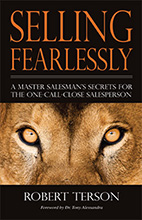 Are sales hunters going the way of the dinosaurs? Is cold calling dead? We’re told by sales experts that prospecting is no longer effective in this age of social media and information abundance. You have to find new customers through referrals and social media, and cold calling is ineffective.[1]
Are sales hunters going the way of the dinosaurs? Is cold calling dead? We’re told by sales experts that prospecting is no longer effective in this age of social media and information abundance. You have to find new customers through referrals and social media, and cold calling is ineffective.[1]
Mike Weinberg begs to differ, and has written New Sales. Simplified.: The Essential Handbook for Prospecting and New Business Development to solve that problem. He makes an eloquent case for the continuing need for old-fashioned prospecting: selecting targets, cold calling and making appointments to generate new business.
I usually don’t read books about prospecting, because I think of them like diet books—the theory is simple but the doing is hard. Everyone knows that you have to eat less and exercise more, and it’s hard for a book to say something new on the subject or to motivate you for long. That being said, Weinberg has come through and delivered an excellent book which outlines a clear path for generating more revenue and brining in new customers, as long as you’re willing to do the work.
The promise implied in the title of the book is kept. Mike writes in a direct and compelling style, stripping out all unnecessary complexity and jargon out of the simple process of prospecting. Prospecting is a function of numbers, discipline and skill. The first three chapters are about the motivation and discipline needed, and the rest of the book provides the skill in three sections:
Choosing your targets. The key issue is to focus. Although prospecting is generally seen as a numbers game, you can stack the numbers in your favor by quickly eliminating the low-percentage prospects and then selecting a finite and realistically workable list. Weinberg suggests finding companies that “look, feel, and smell” like your best clients. You know you bring value to them, and you have instant credibility, and you speak their language. Then, target their senior executives with the sales story that you develop in the second section.
Marshaling your sales weapons. The most important weapon in your arsenal is your sales story. An effective sales story is written in outside-in fashion; instead of yourself and your company, you need to make the customer the center of your story. I found this to be the most helpful section of the entire book, in that it made me do something I rarely do when I read a sales book. I took out a pen and several sheets of paper and worked through the exercise that Mike suggests for creating a compelling sales story. The first step is to brainstorm as many possible ways as you can think of to complete this sentence: “Companies bring us in when…” You then list common pains you can eliminate, problems you can solve, opportunities you can help them take advantage of, and results they need to generate. The second step is to honestly list your differentiators in plain language. It’s a simple exercise, but very eye-opening and very productive.
Planning and executing the attack. I have some differences of opinion with Mike’s suggested approach in this section, but overall I believe his method is very sound and will be effective, for any sales hunters. The main difference might be that I and the clients I generally work with are going after very large accounts, so that there is a smaller population to choose from and a more rifle-shot approach is necessary. I’d like to see more “warming up” the cold call by sending email or using a referral before the first call, and more detailed sales call planning. That said, the differences between us are only in degree, and not in kind.
If you are reasonably new in sales and need a solid and complete manual to learn how to prospect, New Sales. Simplified. is an excellent book for you. If you have been around for a long time and need kick in the back of the pants to get you re-started, plus some excellent suggestions for refining and improving your approach, then this is also the book for you.
This book may make you uncomfortable; it will make you money.
[1] In The Challenger Sale, we’re told that buyers on average have already gone through 60% of their buying cycle before they speak to a salesperson. Maybe that’s because salespeople have stopped calling them.
 One of the analogies I like to use to position my sales approach is that salespeople should be more like doctors and less like pharmacists when they approach customers. That’s not a slam on pharmacists; the pharmacist may know much more about the actual pill that the doctor prescribes than the doctor does, but you go to the doctor first because they know more about you and your needs, and they take the time to diagnose before they prescribe.
One of the analogies I like to use to position my sales approach is that salespeople should be more like doctors and less like pharmacists when they approach customers. That’s not a slam on pharmacists; the pharmacist may know much more about the actual pill that the doctor prescribes than the doctor does, but you go to the doctor first because they know more about you and your needs, and they take the time to diagnose before they prescribe.
Imagine if the situation were turned around. What if your doctor approached you like so many salespeople approach their prospects? Let’s listen in on that conversation.
“Hello, Mr. Malcolm, thanks for coming in today. I’m Dr. Jones, and I’ve been practicing medicine at this location for the past fifteen years. I went to one of the finest medical schools in the country where I graduated third in my class, and I spend several hours each weekend catching up on the latest medical advances in my field.
“Here’s a file containing dozens of unsolicited testimonials from current and former patients. I’ve healed some hopeless cases, restored sight to more than one blind person, and helped famous athletes resurrect their careers.
“Today is an especially good time for you to be here, because we’ve just received a new shipment of the latest cholesterol drug. For a limited time, we’re selling a year’s worth for the price of six months and if you act today we’ll throw in a month’s worth of Viagra.
“If you see our office manager on the way out, she will arrange easy financing terms for my recommended course of treatment.
“What, you’re not sure you need the treatment? Mr. Malcolm, surely you’re interested in feeling better and prolonging your life span, aren’t you?
“You say your leg is broken? Well, Jack—may I call you Jack?—that’s all the more reason you need our cholesterol drug. You’ll be off your feet for a while and won’t be able to exercise, and studies show that lack of exercise is a leading cause of plaque build-up…
“Wait, Mr. Malcolm, I’ll throw in half-off on cast removal if you’ll buy today.
“Wow, nurse, I never knew a guy on crutches could move so fast!”
Dogs have it made. They have figured out how to exploit our species for their own personal[1] gain. We like to think they’re our pets, but any objective assessment of the situation would turn that around—we do all the work, while they lay around all day and get fed regularly.
Dogs have reached this coveted status because they are masters of the art of sales. Having observed my own two rescue mutts closely, I’ve discerned the following traits and behaviors that make them so good at what they do:
They can sniff out opportunity anywhere.
Just drop a scrap of food or leave something tasty on the counter, and it will be gone the instant your back is turned. Once they lock on to an opportunity, they are determined to do everything in their power to get it.
They have unbeatable self-confidence.
How many salespeople limit their effectiveness and their earning capacity because they are afraid to call high? If you’ve ever seen a chihuahua go after a mastiff, you know that dogs don’t give a hoot about size or status. Keep this in mind when you’re reluctant to sell outside your comfort zone.
Rejection is not a concept they understand.
You can yell at your dog, and they will feel bad for about a second and a half. After that, it’s as if nothing had happened, and they revert to the behavior they got yelled at for.
They are relationship-oriented.
They don’t bother with challenger or consultative selling because their relationships work so well for them. Salespeople always try to be alert for signals of approval or disapproval from prospects; dogs are intimately aware of our state of mind at all times, through their reading of our body language, tone of voice and facial expressions. With the possible exception of stealing food off the kitchen counter, there is nothing that makes them happier than getting our approval.
They are brimming with energy.
From the moment they come spilling out of their room in the morning to their last time out in the backyard at night, they put everything they have into every moment in life. Watch a dog retrieving tennis balls—with tongues hanging out of their mouths, they run just as hard the 20th time as they do the first. Imagine if your cold calls were like that.
They are unfailingly cheerful and optimistic.
Selling is tough, and it’s easy to get down when things aren’t going your way. Dogs don’t have that problem; they know that even if they don’t get what they want right now, a treat or a scratch behind the ears is just around the corner.
They appreciate the hand that feeds them.
We all have our faults, but to our dogs, we can do no wrong. As salespeople, we have two masters, our employers and our customers; are we as loyal to them as our dogs are to us? We may not agree with everything our employers do, but do we back them up at all times? We may realize that the customer is not always right, but do we keep in mind that they are always the customer?
Of course, dogs are not perfect salespeople. They bark more than they should, but then so do most salespeople.
[1] While I realize the word “personal” doesn’t quite fit, I couldn’t find dogonal in the dictionary.
 As a specialist in complex sales, I rarely read anything that relates to one-call-close sales. I read Selling Fearlessly: A Master Salesman’s Secrets For the One-Call-Close Salesperson
As a specialist in complex sales, I rarely read anything that relates to one-call-close sales. I read Selling Fearlessly: A Master Salesman’s Secrets For the One-Call-Close Salesperson because Bob is a friend, but I’m recommending that you read it because it’s so good. By the time you finish it, you’ll probably feel Bob is your friend, too.
Terson did not sell complex systems to large businesses—he sold advertising on telephone book covers to small businesses, not what you would consider sophisticated sales. Yet, anyone who went on 12,000 sales calls during a 43-year career is bound to have learned a lot about selling, about consistent success, and about the psychology of persuasion. He also has a special gift for teaching, explaining and telling stories, which wraps the valuable lessons of a lifetime into a compelling and entertaining package.
In fact, Selling Fearlessly was a “one-call-close” for me, in that I read most of it through in one sitting while on a flight. But I have already started going through it again, because there are pearls of wisdom disguised as “common sense”, the kinds of things we all think we know but definitely don’t do enough of.
The book is in four sections, with about a dozen short chapters in each that tell a story or make a valuable point. Each chapter is opened by an apposite quote. My favorite is “Personality can open doors, but only character can keep them open,” quoted in chapter 4. Another quote dovetails beautifully with my own Bottom-Line Selling approach: “Treat your role strictly as a fiduciary responsibility and you’re on the right path to selling glory.” (I planned to steal that one, but when I tried it out on my class full of salespeople today, I had to explain what “fiduciary” meant.)
Part I is about the selling life, and the Mound Road story that opens the book (and Terson’s career) introduces us to the man who is our mentor and guide for the rest of the book. Everyone will draw their own lessons from Part I, but for me the key is the importance and dignity of the sales profession, especially since we’re all salespeople in some way.
The next three sections cover one leg of “The Triangle”, made up of mental attitude, work habits and salesmanship. Part II, on mental attitude, is mostly full of ideas that we already “know”, but constantly need reminding of, such as motivation, belief, and persistence. The key takeaway from this is that you don’t have to be born with a natural aptitude for selling; as long as you’re willing to work hard, take responsibility for your own and your customers’ results, and develop a tenacious belief in yourself despite disappointment and rejection, you can create a successful and rewarding career for yourself.
Part III is full of practical advice about work habits. Terson was way ahead of some of the current thinking on applying lean methods to selling—codifying and standardizing his work processes and following them consistently week by week, year over year. Although it would not be possible in today’s rapidly changing world, I found it fascinating that he only made three changes to his selling process in 43 years!
Part IV is about salesmanship. If you have any experience and success in complex sales, you’ve heard of his techniques before and won’t agree with all of them, but occasionally we need reminders that planning, developing relationships and challenging your buyers sometimes needs to be supplemented by the ability to communicate convincingly, deal with objections, and close a wavering decision maker.
Selling Fearlessly will enthrall, teach, and inspire you.



